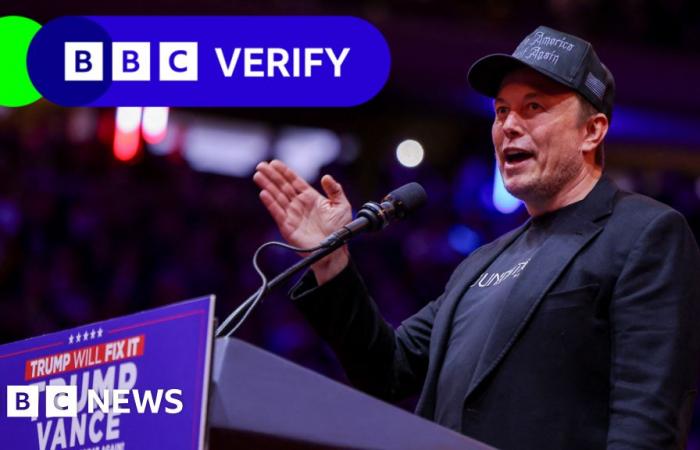 Reuters
ReutersThe boss of Tesla and the social media site X, Elon Musk, suggested last month at Donald Trump’s rally in New York City that it would be possible to cut “at least $2 trillion” from US government spending by eradicating “waste”.
Musk has now been appointed to co-head a new Department of Government Efficiency by the incoming US president, giving him an opportunity to try to put his plans into action.
In the most recent fiscal year (from October 2023 to September 2024) the US federal government spent $6.75 trillion (£5.3 trillion) according to the US Treasury.
This means Musk’s proposed cuts of $2 trillion would represent around a cut of around 30% of total federal government spending — also known as national spending in other countries.
How realistic is that proposal?
To answer that, it’s helpful to break down the total spending figure.
Around $880bn (13% of total US government spending) goes on interest payments on the national debt, which means that line of expenditure cannot be reduced without putting the US government in default.
Around $1.46 trillion (22%) goes on Social Security, which primarily means pensions for Americans over the retirement age. This is a line of spending which is “mandatory”, meaning it must be spent by law on those eligible.
Other large mandatory lines of government expenditure include Medicare – a government-funded health insurance program primarily serving Americans aged over 65.
So-called “discretionary” US government spending – outlays that are not permanently enshrined in law but have to be voted on annually by US lawmakers – includes defence ($874bn, 13%), transportation ($137bn, 2%) and education, training, employment and social services ($305bn, 5%).
Altogether, discretionary spending accounted for around 25% of the total in the 2023 financial year according to the Congressional Budget Officewith more than half of that going to defence.
In theory, discretionary spending would be easier for the incoming Trump administration to cut than mandatory spending.
Donald Trump has said that Musk – and his co-head at the new Department of Government Efficiency, Vivek Ramaswamy – will achieve the savings from dismantling government bureaucracy, slashing excess regulations and restructuring government agencies. In an interview with the BBC in April 2023 Musk claimed to have reduced the staff of Twitter (now X) from 8,000 to 1,500 after acquiring the social network in 2022.
Yet if all of the $2 trillion in US government expenditure savings now being targeted by Musk were to come from discretionary spending, analysts calculate that entire agencies – from transport, to agriculture, to Homeland Security – would have to be entirely closed down. Discretionary spending accounted for only $1.7 trillion in 2023.
Musk did not specify if he would aim to deliver $2 trillion in savings in a single year, or over a longer period, but many US public finance experts, including those who are in favour in principle of reductions in US government spending, are sceptical savings on such a scale can be found in the near term without either a collapse in the delivery of important government functions or sparking major public resistance.
After taking control of the House of Representatives in 2022, Republican lawmakers have struggled to pass legislation to deliver considerably smaller cuts of $130bn in discretionary government spending after meeting opposition from other Republicans.
It’s also important to note that Donald Trump campaigned on a platform of making Social Security more financially generous, not less, by removing the income tax payable on it. And, on defence, Trump said he would build an “iron dome missile defence shield” around America, implying greater spending in this area, not cuts.
Total US federal government spending as a share of the US economy in 2024 was around 23% according to the US Treasury.
That’s a considerably smaller share than national government spending in other developed countries.
However, a large share of government spending in the US, including almost all school spendingis done at a state rather than a federal level, and states are funded by local sales and property taxes.
The International Monetary Fund has projected that total US “general government expenditure”, which includes spending by individual states, will be around 37.5% of its GDP in 2024.
That compares with 43% in the UK, 48% in Germany and 57% in France.
The US government is currently running an annual deficit – a shortfall between its spending and tax revenues – equal to around 6% of its economy. And America’s national debt held by the public is currently equal to around 97% of the size of the economy.
The non-partisan Committee for a Responsible Federal Budget (CRFB) think tank has projected that this is currently set to climb to 125% by 2035.
The CRFB has projected that absent major spending reductions, Donald Trump’s planned tax cuts would considerably widen the US deficit in the coming decade and push up the US national debt to 143% by the middle of the next decade.









